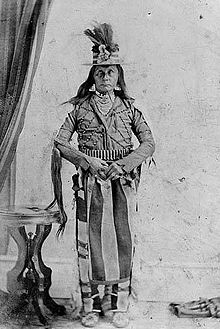Cutmouth John
Cutmouth John | |
|---|---|
 Studio portrait of Cutmouth John, circa 1865. | |
| Allegiance | |
| Service/ | |
| Unit | United States Army Indian Scouts |
| Battles/wars | Yakima War |
Cutmouth John, also known as Poor Crane and as Ya-Tin-Ee-Ah-Witz, Chief of the
Guide
Poor Crane, as he was known at the time, was a guide and friend of Thomas J. Farnham and led him to the Whitman Mission in 1839, three years after it was founded. Poor Crane was described as a kind, middle-aged man who was a devoted father. He loaned Farnham his best saddle and had his two young sons accompany them on the journey to the mission.[3][4]
Whitman massacre
According to the journal of Lawrence Kip, a
During the
Legacy
In 1891 sculptor Olin Levi Warner made an 11-inch bronze sculpture plaque of Poor Crane, Ya-Tin-Ee-Ah-Witz, Chief of the Cayuses. It was one of six legendary Northwest Native Americans that Warner portrayed.[1] Warner met Poor Crane in 1891 when he was the Chief of the Cayuses, living in northeastern Oregon on the Umatilla Reservation. He was described as "the embodiment of the wilderness, a creation of nature... He still keeps to the simple wants of the savage, still lives as he has always lived, accepting the good and evil of his life with fortitude, and above all things insists that a man needs only two virtues - bravery and truth."[7]
References
- ^ a b Poor Crane, Ya-Tin-Ee-Ah-Witz, Chief of the Cayuses by Olin Levi Warner. Archived 2014-05-25 at the Wayback Machine Lure of the West, Treasures from the Smithsonian American Art Museum. Retrieved May 24, 2014.
- ^ a b Kip, Lawrence (1999). Indian War in the Pacific Northwest. University of Nebraska Press. p. 32.
- ISBN 978-0-8061-3710-0. p. 65.
- ^ Whitman Mission National Historic Site. National Park Service. Retrieved May 24, 2014.
- ^ Splawn, A.J. (1917). Ka-mi-akin, the Last Hero of the Yakimas. Kilham Stationery & Printing Company. pp. 39–51.
- ISBN 9781465541536.
- ISBN 978-0-87099-914-7. p. 232.
Further reading
- Michael Hollister. Salishan. AuthorHouse; 1 December 2007. ISBN 978-1-4343-5358-0. p. 28.
- Oliver Otis Howard. Famous Indian Chiefs I Have Known. Century Company; 1922. pp. 340–352.
- Lawrence Kip. Indian War in the Pacific Northwest: The Journal of Lieutenant Lawrence Kip. U of Nebraska Press; 1859. ISBN 0-8032-7791-1. pp. 60, 122.
- Robert H. Ruby; John Arthur Brown. Indians of the Pacific Northwest: A History. University of Oklahoma Press; 1988. ISBN 978-0-8061-2113-0. p. 148.
